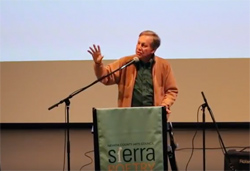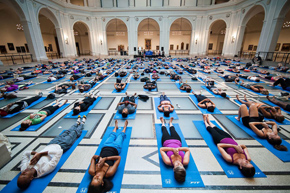Sometimes, during the busiest weeks, we need to find time to slow down. I did—and in two blog posts about current approaches to art I noticed, and cheered for, implicit heresies.
* * *
 First, via Cynthia Haven, comes video of California poet laureate Dana Gioia at the first annual Sierra Poetry Festival in April 2017. I’ve long been a fan of Gioia, but the first seven or eight minutes of his casual talk sum up every simple, contrarian impulse I enjoy in 21st-century poetry, which is as much of a niche pursuit as any can be. Gioia addresses a fellowship he describes as having “dedicated significant part of our lives, in a broader sense, to something our society doesn’t much value. We are people at odds with the values that are trumpeted around us in the media,” adding that poets aspire to exchange money, power, and social status for beauty, truth, and goodness. If your first impulse is to laugh at that, please think again: Almost nobody makes money with poetry, and doing something you love for its own rewards is actually a lot more normal than hoping your beloved hobby will turn a profit, earn you “likes,” or make you “YouTube Famous.”
First, via Cynthia Haven, comes video of California poet laureate Dana Gioia at the first annual Sierra Poetry Festival in April 2017. I’ve long been a fan of Gioia, but the first seven or eight minutes of his casual talk sum up every simple, contrarian impulse I enjoy in 21st-century poetry, which is as much of a niche pursuit as any can be. Gioia addresses a fellowship he describes as having “dedicated significant part of our lives, in a broader sense, to something our society doesn’t much value. We are people at odds with the values that are trumpeted around us in the media,” adding that poets aspire to exchange money, power, and social status for beauty, truth, and goodness. If your first impulse is to laugh at that, please think again: Almost nobody makes money with poetry, and doing something you love for its own rewards is actually a lot more normal than hoping your beloved hobby will turn a profit, earn you “likes,” or make you “YouTube Famous.”
The statement that struck me the strongest was this: “We don’t lead global lives.” Heresy! For all we learn from other perspectives and wider views, we can’t escape our own terroir, though many try. At a time when we’re supposed to aspire to be “global citizens,” whatever that is, Gioia preaches diversity of place, of values, of expression. I’m glad he does; those offer something true for all of us.
* * *
 And then there’s this from the website Artsy: “Why the Rise of Workout Classes in Museums Should Worry Art Lovers.” Do we really need an “explainer” on this? I understand that some museums have grave financial problems, and I attended several museum conferences a few years ago where older administrators were openly terrified by their inability to attract a younger audience with the attention span of a capsized stinkbug. Turning art spaces into noisy, oniony locker rooms is not the answer. Museums have tried these stunts for a while; symphonies have also tried to cash in with gimmicks like crowd-pleasing concerts of orchestral versions of video-game tunes. In the long run, do these things attract more patrons than they repel? No one has said.
And then there’s this from the website Artsy: “Why the Rise of Workout Classes in Museums Should Worry Art Lovers.” Do we really need an “explainer” on this? I understand that some museums have grave financial problems, and I attended several museum conferences a few years ago where older administrators were openly terrified by their inability to attract a younger audience with the attention span of a capsized stinkbug. Turning art spaces into noisy, oniony locker rooms is not the answer. Museums have tried these stunts for a while; symphonies have also tried to cash in with gimmicks like crowd-pleasing concerts of orchestral versions of video-game tunes. In the long run, do these things attract more patrons than they repel? No one has said.
In my 21 years in D.C., I learned to laugh at Capitol Hill workaholics who pretended that a few hours of weekly yoga balanced out their frantic attempts to get noticed after working until dawn on those brilliantly persuasive bar graphs in a sorghum-subsidies report for the assistant to Senator Bedfellow. Learning to be alone to exhume your own thoughts is (to use the language of the stressed) a lifestyle choice—no piped-in soundtrack to every meal, no CNN or Fox News blaring overhead as you try to read a book or reconnect with a friend, no checking your phone every six minutes for nonsense.
I like music. I like video games. Yoga is good for you. I value my smartphone. But I’m zealous about there being one secular place left in our culture that isn’t about bodies rather than minds, or doing rather than thinking, or noise rather than silence, or therapeutic self-improvement rather than grappling with the difficult thinking of older, wiser minds. I suppose that’s my heresy. I support it with my wallet, but for now I’ll continue to live in the woods.

Our attention has been monetized. Google, Facebook, the TV and radio companies, sell off bits of it to their advertisers. The economies of scale mean that the social media companies require this attention in tiny bits: the thirty-second TV commercial is an epic compared to the ad seen from the corner of your eye as you look at a blog or update. Why then, not train your audience to hand out its attention in small, convenient bits?
I assume that the Hill types in fact have a considerable power of concentrated attention. Their use of it may weary rather than strengthen them, I suppose.
LikeLike
I’ll take a look at the Dana Gioia video–thanks. Although I’m not much of a conference-goer, I have gone to West Chester twice (to be on or run a panel) and met him there. You’re not that far away… you might enjoy it! Or have you been?
While I was at Williamstown last weekend, I noticed that the Clark Art Institute now has free yoga classes on the big stone patio by the reflecting pool… In that case, it didn’t seem quite so odd because class takes place outside, and there are many trails on the property. But it is a sign of the times, when orchestras, bookstores, museums, opera companies, etc. all try to be “relevant” and appeal to the young. To change one’s nature in order to be seen is tricky, particularly when changing something precious.
LikeLike
George: Indeed, and I think that in the years ahead, concentration and focus–the ability to finish reading a long book–will even more starkly distinguish the marketers from the marketed-to, the leaders from the led, the makers from the consumers.
Marly: I’m even more conference-shy than you are, so I’ve not yet been to West Chester. Maybe someday. And you know, I’m willing to change my tune on museums’ plays for “relevance” if they can show that these programs attract new members or other long-term supporters of what I suppose marketeers would call their “core mission.” When I attended several national and regional museum conferences in 2012 and 2013, I was struck by how few middle-aged museum professionals were willing to defend the idea that their institutions had something to offer young people on the museums’ terms. I don’t begrudge younger people their interests; I’d just feel negligent if I didn’t try to preserve something they don’t yet know they’ll need when they’re older.
LikeLike
The only reason I’ve been is that I was invited, I’m afraid… Why do I need to be invited? I don’t know.
That’s interesting: the idea that the museum people didn’t think they had something to offer to the young. Sad attitude! And yet there are still young people who paint and draw and write and dance….
LikeLike
Yes indeed: it’s become clear to me that the so-called “hipsters” in the 18-30 demographic have a strong interest–perhaps stronger than my generation did–in art and culture that’s bigger and older than themselves. For every insufferable rich-white-city-kid culinary fad or trendy tech boondoggle, there are many more millennials doing wonderful things: perpetuating regional musical traditions like Zydeco, defying consumerist trends by opening high-quality butcher shops, exploring the potential in old-fashioned film photography…today I read about a young guy in Baltimore who bought a tiny historic home and turned it into a little private museum of black history and culture.
Museums, art, and high culture are bound to appeal only to a minority of any generation. While I want everyone to know this stuff is there for their enjoyment and edification, I’d like to see museums and similar institutions target potential hardcore supporters first, before thinking they need to have broad appeal to such a vast and fragmented generation.
LikeLike